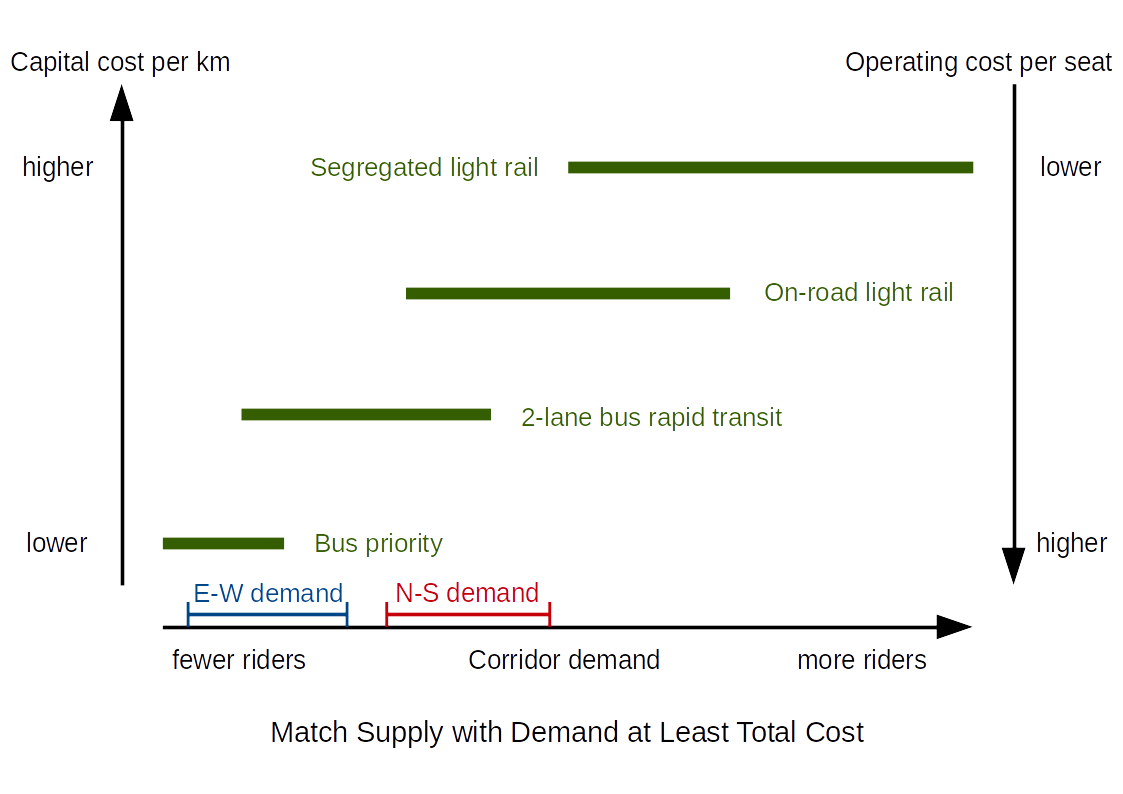Other FIT Wellington pages:
- A New Public Transport Approach
- A Suggested Route
- Advancing Light Rail for Wellington
- Advocacy or Consultancy
- Are we on track
- Art of Light Rail Insertion
- Auckland Light Rail Options
- Briefing to Transport Minister
- Bus and Light Rail in Central Wellington
- Bus Rapid Transit is Unsuitable
- By the Numbers
- Can Light Rail Attract Enough Demand
- City of Well Connected Communities
- Comparing Canberra and Wellington
- Congestion Free Wellington
- Draft GPS on Land Transport
- Estimating Travel Time
- FIT Wellington
- Funding Light Rail
- Glossary
- Golden Mile Trial
- Letter to Capital Magazine
- LGWM Options Feedback
- LGWM Submission
- Light Rail Costs
- Light Rail Design Brief
- Light Rail FAQ
- Light Rail Options Survey
- Light Rail Planning Assumptions
- Light Rail to Lincolnshire Farms
- Making Tram-Train Work
- Mass Rapid Transit in Wellington
- Ministerial Talking Points
- Move More People with Fewer Vehicles
- Moving on from LGWM
- Myth Busters
- N2A Talking Points
- NZTA Talking Points
- Open Letter on Trackless Trams
- Open Letter to LGWM
- Paul Swain Monday 1 February 2016
- Planning Principles
- Public Transport in Wellington
- Public Transport Spine Issues
- Public Transport Spine Study
- Public Transport Spine Workshop
- SH 1 Wellington Improvements
- Spatial Plan Submission
- The Case for Light Rail
- Three Minute Summary
- Towards Low Emission Cities
- Track Gauge
- What Makes Light Rail Succeed
- What Next for Transport in Wellington
- Workshop Code of Conduct
I support the submission from FIT Wellington. In my view, Option 4 is the best option (south coast light rail via Taranaki Street), including the improvements FIT has proposed.
PDF settings (show)
Option 4 has the lowest delivery risk. Deliverability must be a foremost consideration in choosing a preferred option. Evidence from past large government infrastructure projects shows that two factors play a critical role in determining success: replicable modularity in design and speed in iteration. Option 4 best meets these criteria. Design patterns from the N–S line can be reused on the E–W (Miramar to Karori) corridor.
Some people have criticised Option 4 for bypassing the demand from Mt Victoria. This is a strength, not a weakness. Bus priority to the eastern suburbs will ensure Mt Victoria continues to enjoy good bus service. A future E–W rapid transit corridor is likely to follow Cambridge Terrace between Wakefield Street and the Basin Reserve. This will enhance the service to meet growing Mt Victoria demand, which in turn will strengthen the case for E–W mass rapid transit.
Whichever option is eventually chosen, the implementation timetable must be radically shortened. By 2050, we need to transform Wellington from a car oriented city to a transit oriented city. To achieve this system redesign, LGWM needs to deliver two mass rapid transit projects per decade, for the next 30 years. Other cities are doing this; so can we.
Previously, LGWM defined mass rapid transit as having the following characteristics:
- High-frequency services (every 10 minutes or less)
- Modern, high capacity electric vehicles with superior ride quality
- Fast loading and unloading
- Dedicated lanes with signal priority
- High-quality stations with level boarding
LGWM’s proposals deliver on 4 out of these 5 characteristics, but none of the options provides dedicated lanes with full signal priority south of Newtown. This is likely to make the service slower and less reliable — streetcar rather than metro. I encourage LGWM to investigate ways to bring the design closer to the original mass rapid transit vision, or explain why it is unable to do so. Silently moving the goal posts is not good enough and suggests weak governance.
All options will generate greenhouse gas emissions during, and arising from, construction. The cost of offsetting these embedded emissions, such as by restoring some of the region’s degraded wetlands, needs to be accounted for in the business case for this and other large infrastructure projects. Carbon offsets are part of the capital project cost. Best environmental practice for on-street light rail is to minimise embedded emissions by use of lawn tracking. Instead of a concrete light rail surface, lawn tracks incorporate grasses and groundcover plants over infilled soil. LGWM has a duty of care to include a light rail option that embodies these principles.
Investment logic illustrates the investment logic for different transit modes. It shows the lower unit operating cost of higher capacity modes overcomes their higher capital cost, provided there is sufficient demand. Hence the success of Option 4 (and all options with streetcars to Island Bay) depends on there being sufficient demand on the N–S corridor to fill the vehicles. The benefit realisation plan must identify ways to:
- achieve mode-shift from private cars to mass rapid transit;
- develop medium-density, amenity-rich, transit-oriented communities around the stations; and
- encourage more MRT rides per person, such as offering unlimited travel for a fixed monthly fee.
 Δ
Δ▴ Mass Rapid Transit investment logic
- ✒
- John Rankin